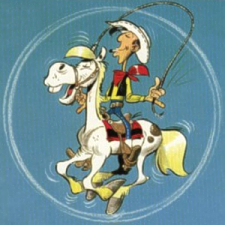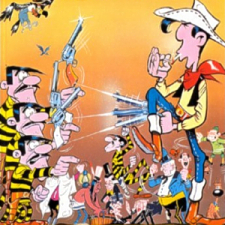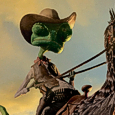Studio Idefix/Buena Vista (1971-1978), CLV, 2 double sided individual discs, 1.33:1 full-frame, Mono, Not Rated
 While America, and of course Disney, has taken much credit for the state of mainstream animation, audiences do tend to forget that a great deal of quality animation is also produced overseas each year, and in France, the home of “film art”, especially. A country with a strong background in graphic arts, comic books, or “albums” as they are know there, have always been a choice way of passing the time and their home-grown characters are second to none in the popularity stakes. Asterix The Gaul, Lucky Luke the lonesome cowboy and even neighboring Belgium’s Tin Tin are among the top selling characters, with cartoon series and live-action films based on their exploits continuing to break box-office figures.
While America, and of course Disney, has taken much credit for the state of mainstream animation, audiences do tend to forget that a great deal of quality animation is also produced overseas each year, and in France, the home of “film art”, especially. A country with a strong background in graphic arts, comic books, or “albums” as they are know there, have always been a choice way of passing the time and their home-grown characters are second to none in the popularity stakes. Asterix The Gaul, Lucky Luke the lonesome cowboy and even neighboring Belgium’s Tin Tin are among the top selling characters, with cartoon series and live-action films based on their exploits continuing to break box-office figures.
After another comic album writer, Hergé, had great success with Tin Tin’s translation to the screen in the late 1950s (resulting in a number of feature outings from 1964 onwards), Albert Uderzo and Rene Goscinny, the creators of the Asterix albums, could see the animation potential in their comic and teamed with their publisher’s motion picture arm, Dargaud Films, to set up an “in house” facility, named Studio Idefix, to carry out production themselves. The first Asterix The Gaul film was released in France to wide acclaim and big box-office success, with an English dubbed version quickly marketed overseas to equal praise. A sequel naturally followed in 1968.
Flushed with success, Studio Idefix veered off into other territories, albeit still keeping within the confines of animated incarnations of the comic albums, and continued their work by adapting another popular French character to the screen, this time with more “international” (read: American) appeal – Lucky Luke. Set in America’s old west, the comic was, like Asterix, based on Goscinny’s original stories, which he had written before Asterix as part of his earlier Morris-Goscinny partnership. “The adventures of the man who draws more quickly than his shadow” were introduced in 1946 under the title Arizona 1880, with the solitary cowboy named in the title of the strip soon after. In the late 1980s, Disney’s Buena Vista acquired video rights to the two theatrical Lucky Luke titles, which surfaced as bare bones but decent LaserDisc releases.
LUCKY LUKE: DAISY TOWN (1971, 75 mins, CLV, Digital Sound) is quite simply one of the best non-Disney animated features I’ve ever seen. Lip-sync here isn’t a problem, and the voice characterizations are spot on. There isn’t a moment in this comic western that isn’t enjoyable, from the “lonesome cowboy” stereotype to the wild-gang baddies and the clink-click of the boot stirrups in the final showdown. Yes, we’ve seen it all before in a bunch of live-action pictures, and the American Tail sequel Fieval Goes West did attempt the same, but here’s the original, folks, with more zip, verve and panache than all of them tied up together. It’s pastiche in its purest form, with a knowing nudge-nudge-wink-wink to the audience that little’uns will find suspenseful and adults will get a kick out of in keeping an eye out for the references and detailed gags.
I first saw Lucky Luke when I was around six years old, and I loved it! The LaserDisc release was all that I’d hoped it would be (except for the abrupt side change, which cuts a scene in the middle instead of coming on a natural fade out as in the Asterix discs). By far and away the best of the bunch when it comes to Studio Idefix’s movies on Buena Vista’s discs, Lucky Luke combines the comics of Morris and Goscinny with the best that the Idefix had to offer. Perhaps mindful of its international appeal – and the fact that it is set in the Old West – the backgrounds have all been created with English text in them. I’ve never seen this one in French, so I don’t know if the French original was like this, but at the time the Studio created this they did have some American staff working in the layout department so it is more than probable. Whatever the circumstances, it does add a degree of “authenticity” to the film.
The “voice cast” give it their all, and along the way we’re treated to all manner of Western-associated performers, notably “James Stewart” as the narrator and the saloon entertaining “Mae West” – many of whom are performed by legendary vocal chameleon Rich Little. The whole film, in this English language version, works so well, from the backgrounds and voices to the songs, one of which, Lonesome Cowboy, actually turned out to be something of a moderate hit record! All the Western clichés are turned on their heads and there are too many great gags to mention here, suffice to say that the Studio pulled out all the stops on this one!
Never actually referred to as Daisy Town in the credits, this first Lucky Luke adventure sees the lonesome cowboy and his ever-present steed Jolly Jumper wander into newly built Daisy Town, where he is quickly appointed Sheriff. The rampant card sharking, stick-ups and bar brawling is soon a thing of the past and Daisy Town comes to be known as one of the safest places in the West! That is, until the Dalton Gang of four desperate desperados mosey on into town. Scaring the townsfolk, they command the run of Daisy Town, announcing themselves as the new Mayor, Sheriff and Judge in these parts. Luke hits on the idea of backing their slow-witted (and out of work) brother as a rival candidate that soon pits the brothers against themselves. They finally realize that the only way to outsmart Lucky Luke is as a group, and the stage is set for the most animated showdown in film history – and I haven’t even mentioned the Indians yet!
The film has a suitably epic feel and the panoramic views of the stunning old West are wonderfully rendered and extremely detailed. The print has a few speckles around the reel changes, but otherwise looks almost as good as new, with a surprisingly sharp image. The audio is just as pleasing, with dialogue crystal clear and the music, although again only in mono, is very spatial. There is a great deal of enjoyment to be had with Lucky Luke: Daisy Town, and if you can find a copy it makes a nice alternative to the sometimes crude (but no less funny) antics of Mel Brooks’ Blazing Saddles, which came four years later and draws upon many of the same elements. Very highly recommended!
 LUCKY LUKE: THE BALLAD OF THE DALTONS (1978, 82 mins, CLV, Digital Sound) isn’t as successful, with the voice dub featuring a whole new roster of talent. Animation wise, it still has bags of quality, but the story is thinner and seems to drag in the movie’s midsection. While the first film packed in every western reference under the sun, this second outing changes things somewhat in its English language dub, especially the Daltons’ characterizations. In Daisy Town the similar-looking but oddly-sized Daltons were given a humorous spin by having each brother speak with the voices of famous Warner Brothers movie gangsters (including Cagney, Bogart and Robinson), whereas here the dubbing direction is less imaginative and they are more generic Western wrong-doers. Certainly the artists at Idefix were improving all the time and the depth and quality in the animation is leaps and bounds ahead of what was achieved in the first Asterix movie.
LUCKY LUKE: THE BALLAD OF THE DALTONS (1978, 82 mins, CLV, Digital Sound) isn’t as successful, with the voice dub featuring a whole new roster of talent. Animation wise, it still has bags of quality, but the story is thinner and seems to drag in the movie’s midsection. While the first film packed in every western reference under the sun, this second outing changes things somewhat in its English language dub, especially the Daltons’ characterizations. In Daisy Town the similar-looking but oddly-sized Daltons were given a humorous spin by having each brother speak with the voices of famous Warner Brothers movie gangsters (including Cagney, Bogart and Robinson), whereas here the dubbing direction is less imaginative and they are more generic Western wrong-doers. Certainly the artists at Idefix were improving all the time and the depth and quality in the animation is leaps and bounds ahead of what was achieved in the first Asterix movie.
This time around the Daltons find that their Great Uncle has left them a huge fortune in his will. Only it seems that in order for the will to be executed the Uncle wants his nephews to “take care” of the Judge and jury who put him away all those years ago. Trouble is he also appointed the one trust-worthiest man he knew to make sure the Daltons carry out his wishes – Lucky Luke himself! Breaking out of jail, they capture Luke and make a deal to split the gold with him if he helps out, with the intention of disposing our hero before he can claim his reward. Of course, Luke hasn’t turned bad at all and manages to warn those on the hit list and turn the tables on the Daltons…
As the most recent film in Buena Vista’s four Studio Idefix releases, the print is in pretty good shape, with hardly any scratches or wear, and completely English credits and titles. It seems it could be that this the one movie from Idefix that was printed to film at 1.66:1, as there were two shots that seemed cramped in this 1.33:1 full-screen presentation, but otherwise framing was balanced and those shots might have just been how the film was transferred as opposed to losing (the tiniest of) picture information from the sides.
As a movie, Ballad Of The Daltons is not quite as much fun as Daisy Town, and is more episodic in nature. There’s some bits of business with the prison dog Rin Tin Can which isn’t as funny as it should be, and an elaborate musical dream sequence that, while great fun, doesn’t really push the story forward. However, some parts (the W. C. Fields travelling salesman and the old abandoned mine shaft cart ride) are more than up to the high standards of the first film. All in all, this may not have the whiz-bang CGI of a certain po-faced Stallion Of The Cimarron, but it certainly has a lot more humorous Spirit!
Unfortunately, due to the expensive nature and low-returns of animation in the 1970s, the Idefix Studio had to shut their doors a few years later, although the characters they helped to make world-famous live on. Rene Goscinny died at the age of 51 in 1977, with Albert Uderzo continuing the Asterix strips himself. Lucky Luke made a brief re-appearance in a poorly conceived Hanna-Barbera version in 1983, and again as an American live-action TV series with Terrence Hill in the early 1990s. It is, however, these animated films that capture the spirit of the comics best, as might be expected. The Asterix and Lucky Luke movies continue to be made available in various configurations on DVD internationally, and in the past couple of years a new 52-episode season of a Lucky Luke cartoon show has been promoted at television markets worldwide. I only saw a brief clip of the series, but it did seem to take its inspiration from the animated feature films, which, for some plain, good, historical fun, you really can’t beat. And that’s straight-shootin’ talk!




